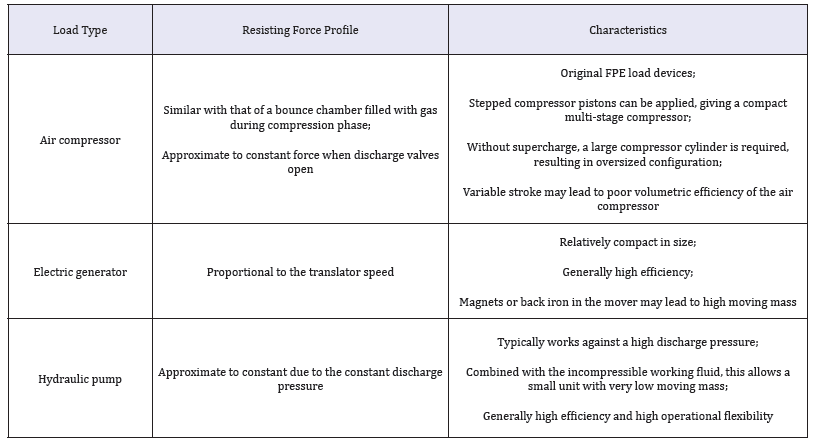- Submissions

Full Text
Evolutions in Mechanical Engineering
Free-Piston Engine (FPE) Technology with Different Applications
Boru Jia1,2*
1 Department of Mechanical Engineering, Beijing Institute of Technology, China
2 Newcastle University,UK
*Corresponding author:Boru Jia,Department of Mechanical Engineering, Beijing Institute of Technology, Beijing 100081, China,Sir Joseph Swan Centre for Energy Research, Newcastle University, Newcastle upon Tyne NE1 7RU, UK
Submission: June 12, 2018;Published: June 27, 2018

ISSN: 2640-9690Volume1 Issue1
Introduction
The free-piston engine (FPE) is a linear engine in which the requirement for a crankshaft system is eliminated and the piston assembly has a free and linear motion[1]. First proposed around 1930, FPEs were in use in the period 1930-1960 as air compressors and gas generators and provided some advantages over presenttime conventional combustion engines and gas turbine systems[2]. They are known to have a greater thermal efficiency (40-50%) than an equivalent and more conventional reciprocating engine (30-40%)[3]. A driving force behind the interest in free-piston engine generators is the automotive industry’s increasing interest in hybrid-electric vehicle technology. Much work has been undertaken by number of research groups worldwide, including the authors’ group, to explore the operation characteristics of FPEs[4,5].After initial investigations and development of freepiston related products during the early to mid-20th century, recent advances in control and real time actuation systems have enabled the technology to become a viable alternative to reciprocating technologies, and as such, research is now being carried out by number of groups worldwide [3,6-9]. Modern applications of the FPE concept have been proposed for the generation of electric and hydraulic power, typically in hybrid electric vehicles[10-15]. Known FPE applications include electric generators, hydraulic pumps and air compressors[2], which are summarised in the Table 1 below.
Table 1: FPE applications.

For FPEs, the elimination of the crank mechanism significantly reduces the number of moving parts and therefore the complexity of the engine[16]. This gives a number of advantages: reduced frictional losses due to the mechanical simplicity and the elimination of the piston side force in crankshaft engines; reduced heat transfer losses and NOx generation due to faster power stroke expansion; potentially lower maintenance cost and higher reliability due to a compact and simple design; and multi-fuel/combustion mode possibility due to combustion optimization flexibility that resulted from the variable compression ratio [17].
References
- Mikalsen R, Roskilly AP (2008) The design and simulation of a twostroke free-piston compression ignition engine for electrical power generation. Applied Thermal Engineering 28(5): 589-600.
- Mikalsen R, Roskilly AP (2007) A review of free-piston engine history and applications. Applied Thermal Engineering 27(14): 2339-2352.
- Erland M (2005) FPEC, Free piston energy converter. In Proceedings of the 21st Electric Vehicle Symposium & Exhibition, EVS, Belgium.
- Chia JC, Jing LY, Shao YL, Tsung WS, Wen SC, et al. (2013) Dynamic modeling of a SI/HCCI free-piston engine generator with electric mechanical valves. Applied Energy 102: 336-346.
- Boru J, Zhengxing Z, Huihua F, Guohong T, Roskilly AP (2014) Investigation of the starting process of free-piston engine generator by mechanical resonance. Energy Procedia 61: 572-577.
- Peter AJA, Johan PJ Van DO, Jeroen P, Georges EMV (2000) Horsepower with brains: The design of the Chiron free piston engine. SAE Technical Paper, Canada, p. 19.
- Martin G, Lixin P (2000) Free piston engine its application and optimization. SAE Technical Paper, pp. 12.
- Jeffrey GS, Steven MG, Gary VL (1986) RE-1000 free-piston Stirling engine sensitivity test results. National Aeronautics and Space Administration Report, USA.
- Van Blarigan P, Nicholas P, Scott G (1998) Homogeneous charge compression ignition with a free piston: A new approach to ideal Otto cycle performance. SAE Technical Paper, Canada, p. 19.
- Christopher MA, Sorin P, Nigel C, Richard JA, Thomas IM, et al. (1999) Numerical simulation of a two-stroke linear engine-alternator combination. SAE Technical Paper, Canada, p. 17.
- Goldsborough SS, Peter VB (2003) Optimizing the scavenging system for a two-stroke cycle, free piston engine for high efficiency and low emissions: a computational approach. SAE Technical Paper, Canada, p. 22.
- Qingfeng L, Jin X, Zhen H (2008) Simulation of a two-stroke free-piston engine for electrical power generation. Energy & fuels 22(5): 3443- 3449.
- Seppo T, Matti V (1999) Hydraulic free piston engine-the power unit of the future? In Proceedings of the JFPS International Symposium on Fluid Power. Japan Fluid Power System Society 1999(4): 297-302.
- Seppo T, Matti V (1998) On the dynamic characteristics of the hydraulic free piston engine. In ICMA’98: International conference on machine automation, pp. 193-202.
- Shuaiqing X, Yang W, Tao Z, Tao X, Chengjun T (2011) Numerical analysis of two-stroke free piston engine operating on HCCI combustion. Applied Energy 88(11): 3712-3725.
- Boru J, Andrew S, Zhengxing Z, Huihua F, Anthony PR (2016) Design and simulation of a two-or four-stroke free-piston engine generator for range extender applications. Energy Conversion and Management 111: 289-298.
- Boru J, Zhengxing Z, Huihua F, Guohong T, Andrew S, et al. (2016) Effect of closed-loop controlled resonance based mechanism to start free piston engine generator: Simulation and test results. Applied Energy 164: 532-539.
© 2018 Boru Jia. This is an open access article distributed under the terms of the Creative Commons Attribution License , which permits unrestricted use, distribution, and build upon your work non-commercially.
 a Creative Commons Attribution 4.0 International License. Based on a work at www.crimsonpublishers.com.
Best viewed in
a Creative Commons Attribution 4.0 International License. Based on a work at www.crimsonpublishers.com.
Best viewed in 







.jpg)






























 Editorial Board Registrations
Editorial Board Registrations Submit your Article
Submit your Article Refer a Friend
Refer a Friend Advertise With Us
Advertise With Us
.jpg)






.jpg)














.bmp)
.jpg)
.png)
.jpg)










.jpg)






.png)

.png)



.png)






